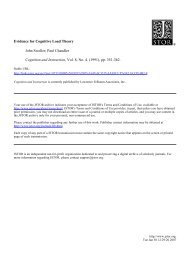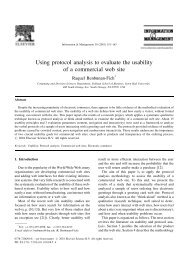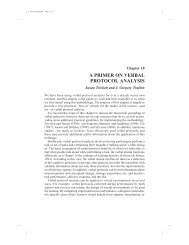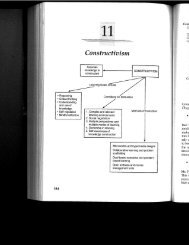Cognitive Theory of Inquiry Teaching-Collins - Ammon Wiemers ...
Cognitive Theory of Inquiry Teaching-Collins - Ammon Wiemers ...
Cognitive Theory of Inquiry Teaching-Collins - Ammon Wiemers ...
You also want an ePaper? Increase the reach of your titles
YUMPU automatically turns print PDFs into web optimized ePapers that Google loves.
258 COLLINS AND STEVENSTABLE 8.3Goals and Subgoals <strong>of</strong> TeachersL Teach a general rule or theory (e.g., Beberman, Anderson, <strong>Collins</strong>).a. Debugincorrenthypotheses(e.g.,Bebermanonnumbersandnumerals,socrates,stevens<strong>Collins</strong>, Feurzeig et al., Anderson on moral education and geography).b. Teach how to make predictions in novel cases (e.g., Beberman, Anderson in arWarman, <strong>Collins</strong>, Feurzeig et al.).2. Teach how to derive a general rule or theory (e.g., Schank, Vy'arman).a. Teach what questions to ask (e.g., Schank, Warman).b.. Teach what is the natue <strong>of</strong> a theory (e.g., Schank, Beberman, Stwens & Collirs).c. Teach how to test a rule or theory (e.g., Anderson in geography, Schank).d. Teach students to verbalize and defend rules or theories (e.g., Warman, Miller, Schank)The most frequent goal is for the student to derive a specific rule or theorythe teacher has in mind. For example, in arithmetic Beberman tried to get stuto derive the rule for addition <strong>of</strong> real numbers, and Anderson the distributive lawIn geography Anderson tried to get the student to understand how distancethe ocean affected temperature, and Stevens and <strong>Collins</strong> tried to get studentsbuild a first-order theory <strong>of</strong> the factors affecting rainfall.ilAlong with trying to teach a particular rule or theory, teachers <strong>of</strong>ten try to elicitand debug incorrect rules or theories. The teachers want the student to conincorrect hypotheses during learning, so that they will not fall into the same traIater. This kind <strong>of</strong> goal is evident in Beberman's dialogue in which he tries tothe difference between numbers and numerals, in Socrates' dialogues in whichtraces the consequences <strong>of</strong>his student's hypothesis down to a contradiction, and iAnderson's dialogues on geography and moral education in which he enstudents into revealing their misconceptions.Another goal that frequently pairs with teaching a given rule or theory ising students how to make novel predictions based on the rule or theory.* Simplknowing the structure <strong>of</strong> a theory is not enough; one must be able to operate on tstructure to deal with new problems. For example, in mathematics Anderson giharder and harder problems for the student to predict the answer.** In<strong>Collins</strong> and Stevens start with cases that exemplify first-order factors and graduamove to more difficult cases to predict. Feurzeig et al. are trying to get studentsdiagnose novel cases. This goal emphasizes the ability to use the theory one hIearned.The other top-level goal <strong>of</strong> inquiry teachers is to teach students how to denew rule or theory. For example, Schank tried to get his students to formulatenew theory <strong>of</strong> planning, and Warman tried to get her preschoolers to devise arule for allocating blocks. Many <strong>of</strong> the dialogues had a similar aim.*klitor's note: This goal is definitely on an application level <strong>of</strong> learning (e.g., Gagné'sskills and Gropper's giving and applying expl"anations).x*Editor's note: This is identical to Gropper's .s¿¿p ing treatments (except that Gropper's tspecify detailed ways in which practice examples are (or can be made) easier or harder.8. A COGNITIVE THEOBY OF INQUIRY TEACHING 259One related ability is knowing what questions to askin order to derive a new ruletheory on your own. For example, Warman teaches her preschoolers to evaluaterule by how fair it is. Schank tries to get students to construct a theory bying taxonomic kinds <strong>of</strong> questions. Feurzeig et al. emphasize consideringt diagnoses before reaching a conclusion.. A goal that underlies many <strong>of</strong> the dialogues is to teach students whatform a rule;þr theory should take. In Schank's case, the structure <strong>of</strong> a theory is a set <strong>of</strong> primi-elements as in chemistry. In one <strong>of</strong> Beberman's dialogues he taught studentsiithe form <strong>of</strong> arithmetic rules, where variables replace numbers in-srder to be seneral.vens' and <strong>Collins</strong>' (1911) notion <strong>of</strong> a theory <strong>of</strong> rainfall was a hierarchicallyized, process theory. The principal method for achieving their goal seems toto construct rules or theories <strong>of</strong> the idealized type.occasionally in the dialogues the teachers pursue a goal <strong>of</strong> teaching studentsto evaluate a rule or theory that has been constructed. For example, in teachingwhat affects temperature Anderson tried to get the student to learn how tolrol one factor while testing for another. After his students had specified a set <strong>of</strong>Tirimitive plan types, Schank tried to get rhem to rest out their theory by applying it1tg,a real-world plan (i.e., becoming president). The strategies teachers use areific to the kind <strong>of</strong> evaluation methods being taught.Finally, it was a clear goal <strong>of</strong> both Warman and Schank to get their students toize and defend their rules or theories. For example, it is clear why Warman's,hildren were always intemrpting to give their ideas: She was constantly encourag-and rewarding them for joining in. Similarly, Schank tried to get each studentthe class to either <strong>of</strong>fer his or her ideas, adopt one <strong>of</strong>the other's ideas, criticize<strong>of</strong> the other's ideas, and so on. Both Warman and Schank stressed the quesing<strong>of</strong> authority in their dialogues as a means to push students to formulate theirideas.These are the top-level goals we have been able to identify so far. They arein Table 8.3 earlier. In pursuing these goals, teachers adopt supportings <strong>of</strong> identifying particular omissions or misconceptions and debugging themvens & <strong>Collins</strong>, 1977). Thus these top-level goals spawn supporting goals thatve the dialogue more locally. This is discussed more fully in the section onstructure.es for <strong>Inquiry</strong> <strong>Teaching</strong>.e have decideduse. Thetol0focus on l0 <strong>of</strong> the most important strategies that inquirystrategies are listed in Table 8.4 together with the teachers;{Mitor's note: It may be helpful to keep in mind that there is a difference between inquiry andapproaches to instruction. Inquíry approaches start with a question, and the remainder <strong>of</strong>instruction attempts to bring the student to an understanding <strong>of</strong> the answer to that question, by<strong>of</strong> either an expository approach or a discovery approach. On the other hand, díscoveryhes do not present a rule (or generality) to the student until after the student discovers it. Theì.btudent may be led to discover something without having first formulated a question related to such






